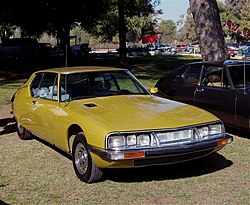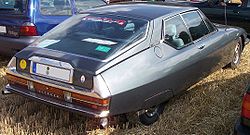Citroën SM

| |
| Citroën SM | |
|---|---|
| Manufacturer: | Citroën |
| Production: | 1970–1975 |
| Body Styles: | FF coupé |
| Engines: | 2.7 2.7 injection 3.0 |
| Predecessors: | None |
| Successors: | None |
| Competitors: | Mercedes-Benz 450SLC Jaguar E-Type BMW 3.0CSi |
| Number built: | 12,920 |

| |
The Citroën SM was a high performance coupé automobile produced by the French manufacturer Citroën between 1970 and 1975.
Overview
Citroën purchased Maserati in 1968 with the intention of harnessing Maserati's high performance engine technology to produce a true Gran Turismo car, combining the sophisticated Citroën suspension with a Maserati power unit.
The result was the Citroën SM (Sport Maserati), first shown at the Geneva Motor Show in 1970.
The SM was Citroën's flagship vehicle, competing with other high performance GTs of the time from manufacturers such as Jaguar, Lotus and Porsche. It was also Citroën's way of demonstrating just how much power and performance could be accommodated in a front wheel drive design.
Contemporary automotive journalists were most effusive about the SM's dynamic qualities, which were unlike anything they had experienced prior. The SM provided a combination of comfort, sharp handling, and high performance not available in any other car at the time.
The look of the car was also quite distinct. Designed in-house by Citroën's chief designer Robert Opron the SM bore a vague family resemblance to it's famous ancestor, the Citroën DS sedan. Seen from above, the SM resembles a teardrop, with much wider track at the front.
The SM was unusually aerodynamic for its era, with a very low drag coefficient. European critics marvelled at the resulting ability to travel for hours at 120mph [200kmh] in comfort. In addition, many of the details reflect M. Opron's American background, notably the truncated 'fins' at the rear.
The SM combined many unusual features - lights that swivelled with the steering, unique self centering and fully powered steering, self levelling headlamps, a wiper mechanism that is 'sensitive' to rain, and many other features that are now common place on cars of today.
The SM's design was timeless; the car was even used in 1999 in a television advertisement where 'a futuristic car was required'. It placed eleventh on the Automobile Magazine 100 Coolest Cars listing.
In 1970 it was a car of the future, the fastest front wheel drive car to be made. It was an example of the car as a symbol of optimism and progressive technology.
Unfortunately, the SM did not find a sufficient customer base in the European GT market, but much of the SM's technology was carried forward to the smaller Citroën CX, launched in 1974 - the DIRAVI steering being the most obvious example. The engine in enlarged 3.0 L form was used in Maserati's own Merak which, together with the Khamsin, used Citroën's high pressure hydraulics.
US exports
The main export market for the SM was the United States. In the USA the market for personal luxury cars was much larger than in Europe, with competitors like the Cadillac Eldorado, Lincoln Mark IV and Ford Thunderbird alongside a large selection of Italian, English, and German imports. Nevertheless, the unique design of the SM made quite a splash and won the Motor Trend magazine Car of the Year award in 1972: unheard of for a non-US vehicle at the time.

The SM's six headlamp set up was illegal in the United States and consequently US specification cars were fitted with four fixed round exposed lamps. At the time, the US law applicable to headlamps dated from 1937. Because the US auto market was an oligopoly, with three competitors controlling 85% of the market, outdated regulations could continue to exist. The law required round sealed beam headlamps of fixed dimension, with no glass casing, height adjustment, or directional adjustment.
Despite initial success, US sales ceased suddenly - Citroën expected (but did not receive) an exemption for the 1974 model year 5mph bumper regulation imposed by NHTSA. The variable height suspension of the SM made compliance impossible. The law as written called for bumpers to be an exact height off the ground at all times, yet according to the laws of physics, cars dip at the nose on braking. Vehicles classified as trucks were always exempt and the entire law was eventually repealed in 1981. The final batch of 134 now illegal 1974 US model SM's were shipped to Japan.
Engines
The SM was sold with three different engines:
- 2.7 L with Weber 42 DCNF carburettors (170 bhp) - a small number sold in the USA were equipped with automatic transmission
- 2.7 L with Bosch D-Jetronic injection (178 bhp)
- 3.0 L with Weber 42 DCNF carburettors (180 bhp) - only available with automatic transmission except in USA
The size of the relatively small 3.0L engine was limited by French puissance fiscale taxation, which effectively banned large displacement vehicles. The engine was also used in the Maserati Merak 1973-1982 and the Ligier JS2 sports car. The final SMs were produced in the Ligier factory in Vichy.
Demise
After the 1974 bankruptcy of Citroën, Peugeot took ownership of the company and in May of 1975 divested the Maserati unit. There was no way to produce any more SM vehicles after this.
Observers often attribute the 1973 oil crisis to the demise of the SM. While it certainly did not help, it is useful to note that many far more profligate cars were introduced at the same time the SM ceased production, like the Mercedes-Benz 6.9. In the US, where the SM was banned suddenly in 1974 by NHTSA, it was actually an economical vehicle relative to its competitiors.
As illustrated under production numbers, SM sales declined starting in 1972. This appears to be attributable to maintenance issues. Most vehicles require only generalist maintenance, where any competent mechanic can properly maintain the vehicle. Certain vehicles, like Citroën and Ferrari require specialist care due to their unique design. While a sturdy car if maintaned rigorously, the SM did require two sets of specialist care - a Citroën specialist, which are widespread in Europe, and a rarer Maserati specialist, to keep the engine in tune. Once potential buyers began to realize this, sales dropped precipitously.
Production numbers
A total of 12,920 SMs were produced during its lifetime. The production figures for individual years were:
- 1970 868
- 1971 4988
- 1972 4036
- 1973 2619
- 1974 294
- 1975 115
The US market took over 2,000 cars, in the years 1972 and 1973. Eliminating the US impact, sales declined a dramatic 40% from 1971 to 1972 and a further 50% in 1973.
Variants
The SM was never produced in right hand drive although a few prototypes were constructed by Middleton Motors, a Citroën dealer in Hertfordshire, England. One of these prototypes still survives.
Coachbuilder Henri Chapron from Levallois-Perret produced a handful of convertibles (SM Mylord) and sedans (SM Opéra). French Presidents from Pompidou to Chirac enjoy touring Paris in the two 4 door convertible Citroën SM présidentielle models, also converted by Chapron.
Heuliez also produced 2 examples of a T-Roof convertible, the SM Espace.
Frua also proposed a concept car based on the SM, closely resembling the Merak.
SM World, a marque specialist in Los Angeles, California, has produced an extended SM pick-up truck and a turbocharged SM, which set the land speed record for its class at the Bonneville Salt Flats, Utah - traveling 202 mph (327 km/h). These vehicles have been memorialised in die-cast miniature.
The Maserati Quattroporte II was a Maserati-badged, 4-door variant of the SM, with an angular body designed by Frua.
Appearances in art & famous owners
Like the Citroën DS, the SM has made prominent appearances in several films and TV series, and has had many celebrity owners. Emperor and religious icon Haile Selassie I of Ethiopia had an SM, while Ugandan stongman Idi Amin had seven of them. The Shah of Iran drove an SM. Actors Lorne Greene and Lee Majors, President of the USSR Leonid Brezhnev, composer John Williams, soccer star Johann Cruyff, entertainers Jay Leno, Cheech Marin, and Thomas Chong were among other prominent owners of the SM.
Burt Reynolds escapes a fleet of police cars behind the wheel of an SM in the 1974 film The Longest Yard. Reynolds liked the car so much in real life, that he gave an SM to his friend Dinah Shore.
Patrick McGoohan drives an SM in a 1975 episode of the American television series Columbo while Gerry Anderson's 1971 television series, The Protectors, prominently featured a platinum blue SM.
Ben Stiller is kidnapped in a green SM in the 2001 film Zoolander.
While not bearing a resemblance to any other car on the market, the SM did resemble the vehicles featured on the 1970 science fiction television program UFO.
